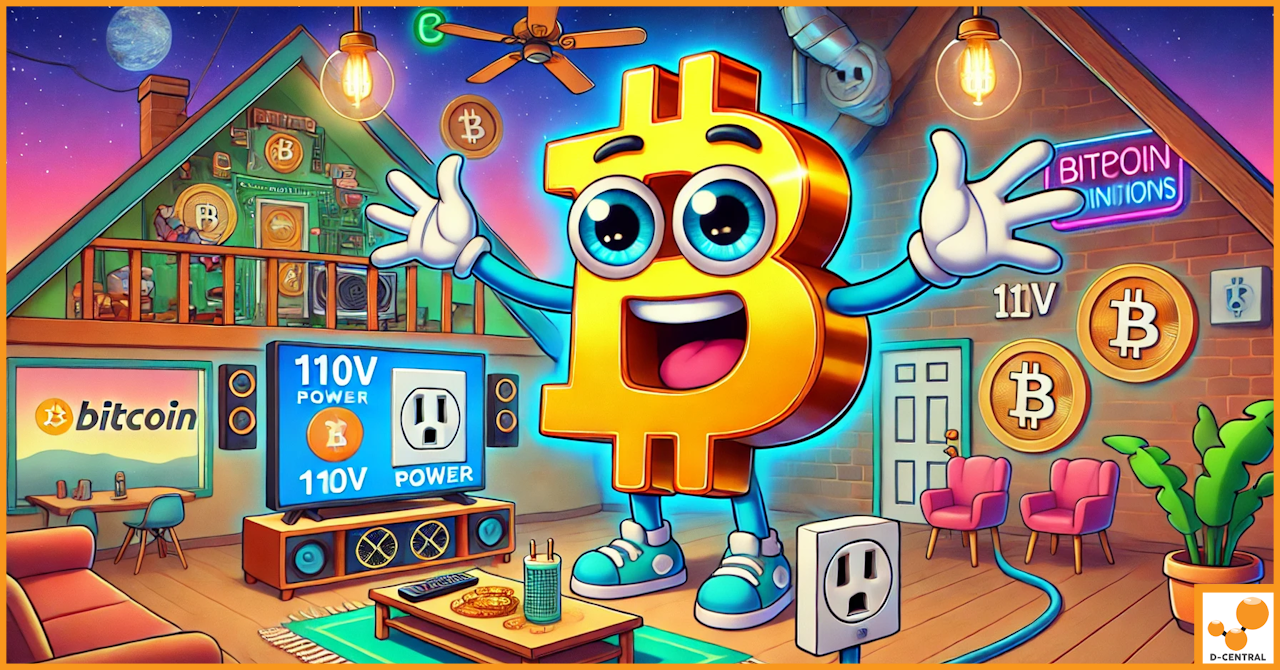
Is Bitcoin Really Backed by Anything? Technology, Trust, or Market Dynamics?
In the ever-evolving landscape of digital currencies, Bitcoin stands as a pioneering force, having ushered in a new era of
4479 Desserte Nord Autoroute 440, Laval, QC H7P 6E2

Bitcoin mining is a vital component of the Bitcoin network. It involves verifying Bitcoin transactions for a reward, through a process that involves complex mathematical computations. This process, while necessary for maintaining the security and integrity of the Bitcoin network, is notorious for its significant energy consumption. According to a report from Cambridge University’s Centre for Alternative Finance, Bitcoin mining annually consumes approximately 145 terawatt hours (TWh) of electricity — an amount roughly equivalent to the power usage of the entire country of Sweden.
This raises an intriguing paradox. Bitcoin, a purely digital entity that exists solely in the realm of bits and bytes, has a substantial real-world environmental impact. For many, this creates a conundrum, a seeming contradiction between the digital and physical worlds. Yet, this also opens up a realm of opportunities. Can we turn this energy demand, often viewed as a negative, into an environmental opportunity? Could the process of Bitcoin mining become a catalyst for new, innovative solutions that not only mitigate its environmental footprint but also contribute positively to the global energy landscape?
Welcome to our exploration of “Bitcoin Mining’s Environmental Opportunities,” where we delve into the innovative solutions that are emerging in response to Bitcoin’s energy consumption. From harnessing surplus renewable energy to implementing energy-efficient technologies, let’s discover how Bitcoin mining is driving a wave of environmental innovation.
The energy-intensive nature of Bitcoin mining arises from the underlying mechanism that secures the network, known as the Proof-of-Work (PoW) algorithm. Miners solve complex mathematical puzzles to add a new block of transactions to the blockchain, a process that requires substantial computational power and, by extension, significant amounts of energy.
Recent data from Cambridge University’s Centre for Alternative Finance indicates that Bitcoin mining consumes around 145 terawatt-hours (TWh) of electricity annually. This level of energy usage puts Bitcoin mining on par with some of the world’s most energy-consuming countries, reinforcing the fact that Bitcoin’s energy consumption is far from trivial.
However, the interpretation of Bitcoin’s energy footprint often depends on one’s perspective. Critics argue that the Proof-of-Work algorithm is wasteful by design, as it requires a continuously growing amount of electricity to function. On the other hand, advocates contend that this energy usage is not a flaw but a feature. They emphasize that the energy consumption of Bitcoin mining secures the network, preserving its decentralization and immutability.
While the debate over Bitcoin’s energy consumption continues, a third perspective is emerging. This perspective sees Bitcoin’s energy usage not as an obstacle but as an opportunity—a catalyst for innovation in energy efficiency and renewable energy solutions. It’s this angle we’ll explore further in our journey into Bitcoin mining’s environmental opportunities.
Among the fascinating approaches towards improving Bitcoin’s environmental footprint, market-based solutions stand out. These initiatives focus on leveraging financial incentives to motivate greener practices in Bitcoin mining.
One such market-based solution involves the use of Renewable Energy Credits (RECs). These are tradable environmental assets representing the generation of one megawatt-hour (MWh) of electricity from renewable energy sources like wind, solar, or hydroelectric power. RECs play a crucial role in offsetting carbon emissions, encouraging the production of renewable energy, and facilitating the transition towards a greener economy.
In an innovative move to turn Bitcoin greener, institutional liquidity provider BlockFills and fund Isla Verde Capital have developed a product that allows miners and investors to offset their energy usage through the purchase of RECs. By tailoring the purchase and retirement of these credits to meet the needs of Bitcoin miners, this initiative allows participants in the Bitcoin network to make verifiable claims about the use of renewable energy sources in their operations.
Besides RECs, market incentives also have immense potential to promote sustainable mining practices. Block Green, a Switzerland-based project, provides an example of this through its decentralized lending protocol. This platform allows liquidity providers interested in Bitcoin-native investments to purchase future hashrate (computing power) over a specific period of time.
The protocol includes a “know-your-miner” feature providing detailed information about the miner’s financials, operational data, and energy sourcing strategy. This level of transparency means that liquidity providers can choose to support miners with sustainable operations, effectively lowering their cost of capital. This dynamic creates a market mechanism that naturally incentivizes miners towards more sustainable practices.
By harnessing the power of market forces, initiatives like Block Green and the REC offering from BlockFills and Isla Verde Capital are carving out a path to a greener Bitcoin.
While market-based solutions provide an essential pathway to greener Bitcoin mining, they represent just one side of the coin. The other side is filled with a myriad of technical innovations aimed at enhancing the energy efficiency of Bitcoin mining operations. These innovations, many of which come to life through the creative application of blockchain technology, have the potential to drastically reduce Bitcoin’s energy footprint.
Blockchain technology has proven to be a game-changer in the promotion of clean energy use in Bitcoin mining. Initiatives such as the Clean Incentive and the Sustainable Bitcoin Protocol (SBP) are prime examples of this.
Clean Incentive aims to “collect, validate and tokenize ESG [environmental, social, and governance] attributes” from a network of miners. Meanwhile, the SBP allows miners to verify their use of clean energy with third-party auditors and be added to a registry. For each block reward miners receive, they also obtain a Sustainable Bitcoin Mining Certificate – a blockchain-based asset that can be sold to institutional investors.
Interestingly, the SBP completed its first transaction of a sustainable Bitcoin certificate in February. This event marked an important milestone in the path to environmentally conscious Bitcoin mining.
Another area of technical innovation lies in energy-efficient cooling solutions. LiquidStack, an immersion cooling firm, provides a cutting-edge example. They offer a cooling system that can reduce the energy consumed by computers in Bitcoin mines by a staggering 40%. Additionally, it can also reduce land use by one-third.
LiquidStack’s technology is built on the innovative use of liquids for heat management instead of traditional air cooling. This approach makes it much easier and more efficient to capture and direct excess heat to other uses.
By harnessing the power of technology and creativity, solutions like these are pushing the boundaries of what is possible in energy-efficient Bitcoin mining. They show that with the right incentives and technologies in place, Bitcoin mining can be part of the solution to our energy and environmental challenges.
With the increasing complexity of Bitcoin mining and the need for advanced energy management, software solutions have become an integral part of the mining process. They provide miners with the tools and insights to manage their operations more efficiently and profitably. One such solution that stands out is offered by Lincoin, a Vancouver-based mining services firm.
Lincoin’s software, dubbed “Rails,” integrates real-time data from over 20,000 grid nodes across nine deregulated electricity markets in the U.S. and Canada. This program offers miners the capability to monitor their profitability in real-time, manage and optimize their operations, streamline tasks, and actively participate in grid ancillary services.
But that’s not all. The Rails software also offers unique features that enable miners to participate in demand response programs and heat reuse activities, all aimed at enhancing their environmental footprint.
Demand response is a concept where miners, or other energy consumers, temporarily shut down their operations during times of peak demand. This helps the grid meet consumption needs, and often, miners get paid for participating in such programs. Heat reuse, on the other hand, is the practice of using the excess heat from a mining operation for another activity, such as greenhouse farming.
These activities, made possible through software solutions like Lincoin’s Rails, present a win-win situation. Miners improve their profitability by cutting down on energy costs and generating additional revenue streams, while also contributing to environmental sustainability.
Whether you are a large-scale miner or a smaller player, Lincoin can provide immense value. Large-scale miners use Lincoin to effectively manage their operations and engage in lucrative ancillary services. At the same time, smaller miners use Lincoin to innovate by managing heat in greenhouses, monetizing their surplus solar energy generation, or mining more intelligently.
In essence, software solutions like Lincoin’s Rails are paving the way for a new era in Bitcoin mining, one where efficiency, profitability, and environmental sustainability go hand in hand.
Bitcoin mining, often criticized for its significant energy consumption, is not only an issue but also a potential solution. The market-based and technical innovations discussed throughout this article provide an optimistic outlook on how Bitcoin mining can benefit the grid and the environment. From the application of Renewable Energy Credits to promote green energy use to software solutions that enhance operational efficiency, Bitcoin mining is continuously evolving to meet the demands of a sustainability-conscious era.
Even more promising is the role that Bitcoin mining can play in leading the path to a sustainable future. By integrating these innovative solutions, we can transform Bitcoin mining from an energy-intensive activity to a catalyst for renewable energy adoption, carbon emission reductions, and efficient energy use. This not only addresses the environmental challenges associated with Bitcoin mining but also strengthens the overall sustainability of our energy systems.
At D-Central Technologies, we understand the importance of this transition and are dedicated to supporting Bitcoin miners on their journey towards sustainable operations. We offer a wide range of services, including consultation, sourcing of mining hardware, hosting mining operations, ASIC repairs, and maintenance training. Whether you’re looking to start your own mining operation or need support with existing setups, we’re here to help.
By leveraging our expertise and commitment to sustainability, you can make a meaningful contribution to the environment while staying profitable in the Bitcoin mining industry. Contact us today to learn more about how we can help you navigate the path towards sustainable Bitcoin mining. Together, let’s turn Bitcoin’s energy demand into environmental opportunities.
What is the issue with Bitcoin mining and energy consumption?
Bitcoin mining uses a computational process called Proof-of-Work, which requires substantial amounts of electricity. Critics argue that this is wasteful and damaging to the environment due to the high carbon emissions associated with most electricity production.
How much electricity does Bitcoin mining consume annually?
According to data from Cambridge University’s Centre for Alternative Finance, Bitcoin mining consumes about 145 terawatt hours (TWh) of electricity per year, which is approximately equivalent to the total power consumed by Sweden.
What are Renewable Energy Credits (RECs)?
RECs are tradable environmental assets representing ownership of the sustainability of electricity produced. Each REC certifies 1 megawatt hour (MWh) of power produced from renewable sources such as wind, hydro, or solar.
How do RECs benefit Bitcoin miners and investors?
Companies like BlockFills and Isla Verde Capital offer products that allow Bitcoin miners and investors to offset their energy usage with RECs, thereby supporting renewable energy and helping to reduce their carbon footprint.
What is the role of Block Green in promoting sustainable Bitcoin mining?
Block Green is a decentralized lending protocol platform where liquidity providers looking for Bitcoin-native investments can buy future hashrate from miners. The platform incentivizes sustainable mining operations, thus contributing to a greener Bitcoin mining industry.
What are Clean Incentive and Sustainable Bitcoin Protocol (SBP)?
These are initiatives that use blockchain-based incentives to promote the use of renewable energy in Bitcoin mining. Miners that use clean energy can receive certificates that can be traded with institutional investors.
How does LiquidStack’s cooling system contribute to energy-efficient Bitcoin mining?
LiquidStack offers a hardware-based cooling system that reduces the energy used by Bitcoin mining computers by up to 40%. Its technology also makes heat reuse easier and more efficient.
What benefits does Lincoin’s software offer to Bitcoin miners?
Lincoin has developed a program that helps miners manage their operations more efficiently and profitably, including participation in demand response programs and heat reuse activities.
How can Bitcoin mining benefit the grid and environment?
Bitcoin mining can benefit the grid and environment through the adoption of market-based solutions like RECs, technical innovations for energy efficiency, and software solutions that promote operational efficiency and grid responsiveness.
How does D-Central Technologies support sustainable Bitcoin mining?
D-Central Technologies provides a wide range of services including consultation, sourcing of mining hardware, hosting mining operations, and maintenance training, all with a focus on promoting sustainability in Bitcoin mining.
DISCLAIMER: D-Central Technologies and its associated content, including this blog, do not serve as financial advisors or official investment advisors. The insights and opinions shared here or by any guests featured in our content are provided purely for informational and educational purposes. Such communications should not be interpreted as financial, investment, legal, tax, or any form of specific advice. We are committed to advancing the knowledge and understanding of Bitcoin and its potential impact on society. However, we urge our community to proceed with caution and informed judgment in all related endeavors.
Related Posts

In the ever-evolving landscape of digital currencies, Bitcoin stands as a pioneering force, having ushered in a new era of

Welcome to the fascinating world where the realms of gaming and cryptocurrency converge. At the forefront of this innovative crossroads

Welcome to the world of home Bitcoin mining! In this comprehensive guide, we’ll explore how you can join the cryptocurrency